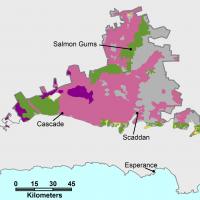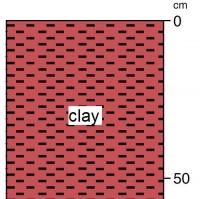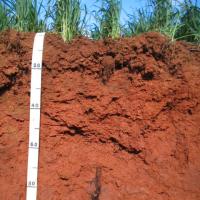Summary
| Occurrence | Brown or red shallow loams over clay subsoils |
|---|---|
| Soil Groups of Western Australia (WA) | 622 Red/brown non-cracking clay |
| Also known as | Kumarl heavy soil, Dowak soil, Clyde Hill soil |
| Australian soil classifications | Grey Vertosol Red or Brown Dermosol, Red or Brown Kandosol |
Distinguishing features
Kumarl is red in colour and is a lighter clay compared to the dark brown medium to heavy clays associated with the Dowak soils. Beete and Geordie calcareous loamy earths are often found on crabhole mounds surrounding the Kumarl and Dowak soils
The Clyde Hill series occupies the lowest depressions of the crabholes and has a self-mulching (~’friable’) surface. Minor Gniess or dolerite rock outcrop may also be associated with the Clyde Hill series.
Surface soil
- Hardsetting loamy to clay textured surface soil with minor gilgai features.
- Clyde Hill has a strongly structured self-mulching surface.
- Neutral to Alkaline.
- Stones and cobbles (Boondies) of lime nodules often found on surface.
Subsoil
- Clays sodic and magnesic with low permeability.
- Carbonates present throughout the profile.
- Alkaline, saline and boron toxic.
Constraints
The following data has been derived from actual site samples taken. These results are recorded in this Excel spreadsheet.
| Rating | Limitation |
|---|---|
| Not applicable (n/a) | No constraints identified |
| Minor | Minor constraint - reduces crop yields in some years |
| Major | Major constraint - reduces crop yields in most years |
| Severe | Severe constraint - will always reduce crop yields |
| Soil Group of WA | 622 Red/brown non cracking clays* | 622 Red/brown non cracking clays* |
| Constraints | Topsoil | Subsoil |
| Acidity and aluminium toxicity | n/a | n/a |
| Salinity | n/a | Severe |
| Sodicity and alkalinity | n/a | Major |
| Boron toxicity | n/a | Severe |
| Poor nutrient retention | n/a | n/a |
| Aggregate stability | n/a | Minor |
| Compaction and hard layers | n/a | n/a |
| Hard setting and crusting | Minor | n/a |
| Water repellence | n/a | n/a |
| Low plant available water | n/a | Severe |
| Water-logging (seasonal) | Minor | n/a |
| Wind erosion (seasonal) | n/a | n/a |
| Water erosion (seasonal) | n/a | n/a |
*Note - Data derived from site identifications (ID's).
- Soil Group of WA - 622 Red/brown non cracking clays site ID includes: Kumarl, DowakSG3.
Further information
McArthur, WM (2004) Reference Soils of South-western Australia (Reprint). Department of Agriculture, Western Australia.
Moore, G (2004) Soil Guide: A Handbook for Understanding and Managing Agricultural Soils. Bulletin 4343. Department of Agriculture, Western Australia.
Overheu, T Muller, PG, Gee, ST and Moore, GA (1993) Esperance Land Resource Survey. Land Resources Series No. 8. Department of Agriculture, Western Australia.
Overheu, T Nicholas, B and Needham, P (1996). Soil Information Sheet for the Mallee Area, Mount Beaumont: Karlsberg Soil Series. Agriculture Western Australia.
Scholz, GGH and Smolinski, HJ (1996) Soils of the Mount Beaumont area. Land Resources Series No. 7. Agriculture Western Australia
Schoknecht, N and Pathan, S (2013) Soil Groups of Western Australia. Resource Management Technical Report 380. Department of Agriculture and Food, Western Australia.




